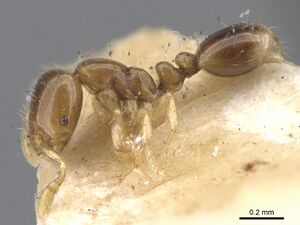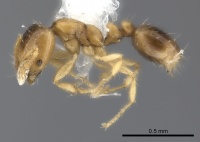Solenopsis azteca
| Solenopsis azteca | |
|---|---|

| |
| Scientific classification | |
| Kingdom: | Animalia |
| Phylum: | Arthropoda |
| Class: | Insecta |
| Order: | Hymenoptera |
| Family: | Formicidae |
| Subfamily: | Myrmicinae |
| Tribe: | Solenopsidini |
| Genus: | Solenopsis |
| Species complex: | brevicornis |
| Species: | S. azteca |
| Binomial name | |
| Solenopsis azteca Forel, 1893 | |
| Synonyms | |
| |
These ants are found in litter in dry forests and in nests with the termite Amitermes medius. Specimens are most commonly collected in litter samples or in pitfall traps. Specimens from the Parque Nacional H. Pittier were collected at Vienna sausage surface bait. They can be collected in primary tropical forest. (Pacheco and Mackay 2013)
Identification
A New World thief ant that is a member of the brevicornis species complex
Pacheco and Mackay (2013) – Worker - The workers of this species are small and color ranges from light yellow to light brown. The head is nearly quadrate and finely punctate. The clypeus is flat, with angular lateral teeth. The scape and minor funicular segments are short. The petiole is wider than the postpetiole viewed laterally. Queen - undescribed).The anterior clypeal margin of the queen is straight and the clypeus is lacking teeth. The frontal lobes are vertically striated with the striae extending posteriorly midway to the dorsum of the head. The eye is large and slightly kidney-shaped. The queen is hairy with long hairs of various lengths (0.06-0.18 mm) on all body surfaces.
Wheeler (1908a) recognized yellow specimens as the subspecies pallida. Color in this species ranges from yellow to brown, with intermediates of all colors occurring (both yellow and brown forms are found in Barbados). Pale yellow specimens occur on Puerto Rico (and exemplify the type series), as well as on Jamaica, Guatemala and Colombia.
The workers are similar to Solenopsis terricola and Solenopsis brevicornis in that all species have short antennal scapes and overlap in their distributions. Although color is often an unimportant character within the thief ants, Solenopsis azteca can be separated on the basis of color, as it is yellow to pale brown while S. terricola (from Central America) is black with yellow appendages. Moreover, S. azteca can further be separated as it lacks sculpturing on the frontal lobes as well as the mesopleuron, whereas S. terricola has vertical striation on the frontal lobes and the mesopleuron is punctated. If a queen is collected, the queen of S. terricola has roughened sculpturing on the petiole and postpetiole, whereas only the basal parts of the petiole and postpetiole are striated in S. azteca. Solenopsis azteca workers can be separated from those of S. brevicornis in that the side of petiole is sculptured, but is completely smooth and glossy in S. azteca.
Solenopsis azteca can be confused with Solenopsis zeteki in the Caribbean as they have both have moderately large eyes and reduced or absent clypeal teeth. However, S. azteca has a no clypeal teeth (resembling the minor workers of the wasmannii group), a short scape and a robust petiole viewed laterally. Solenopsis zeteki can be distinguished as it has angulate lateral clypeal teeth (although greatly reduced), a longer scape and a triangular petiolar node.
Keys
- Key to New World Solenopsis Species Complexes
- Key to Solenopsis brevicornis species complex / Clave para las obreras del complejo brevicornis
Keys including this Species
Distribution
Honduras south to Colombia (Cauca) and northern Venezuela, Caribbean Region.
Latitudinal Distribution Pattern
Latitudinal Range: 19.51666667° to 4.89698°.
| North Temperate |
North Subtropical |
Tropical | South Subtropical |
South Temperate |
- Source: AntMaps
Distribution based on Regional Taxon Lists
Neotropical Region: Barbados, Colombia, Dominica, Greater Antilles, Grenada, Guadeloupe, Guatemala, Jamaica, Lesser Antilles, Netherlands Antilles, Panama, Puerto Rico (type locality), Saint Lucia, Saint Martin (French part), Saint Vincent and the Grenadines, Venezuela.
Distribution based on AntMaps
Distribution based on AntWeb specimens
Check data from AntWeb
Countries Occupied
| Number of countries occupied by this species based on AntWiki Regional Taxon Lists. In general, fewer countries occupied indicates a narrower range, while more countries indicates a more widespread species. |

|
Estimated Abundance
| Relative abundance based on number of AntMaps records per species (this species within the purple bar). Fewer records (to the left) indicates a less abundant/encountered species while more records (to the right) indicates more abundant/encountered species. |

|
Biology
Castes
Worker
Images from AntWeb
   
| |
| Syntype of Solenopsis azteca. Worker. Specimen code casent0902343. Photographer Will Ericson, uploaded by California Academy of Sciences. | Owned by NHMUK, London, UK. |
Nomenclature
The following information is derived from Barry Bolton's Online Catalogue of the Ants of the World.
- azteca. Solenopsis azteca Forel, 1893g: 390 (w.) ST VINCENT & THE GRENADINES (St Vincent I.).
- Type-material: lectotype worker (by designation of Pacheco & Mackay, 2013: 113), 5 paralectotype workers.
- Type-locality: lectotype: St Vincent (no further data); paralectotypes with same data.
- [Note: Pacheco & Mackay do not specify the original syntype series from which the lectotype + paralectotypes were selected. The three original syntype series include: St Vincent & the Grenadines: St Vincent I., 10d: “various situations” (H.H. Smith), St Vincent I., 10e: Petit Bordelle Valley, 1600 ft, 13.xi. (H.H. Smith), St Vincent I., 10i: Richmond Valley, 1100 ft, 29.xii. (H.H. Smith).
- Type-depository: MHNG.
- Pacheco & Mackay, 2013: 112 (q.).
- Status as species: Emery, 1896g: 84 (in key); Wheeler, W.M. 1905b: 124; Wheeler, W.M. 1911a: 23; Mann, 1922: 29; Emery, 1922e: 199; Ettershank, 1966: 139; Kempf, 1972a: 233; Bolton, 1995b: 386; Pacheco & Mackay, 2013: 111 (redescription); Wetterer, et al. 2016: 17; Fernández & Serna, 2019: 815.
- Senior synonym of pallida: Pacheco & Mackay, 2013: 111.
- Distribution: Barbados, Colombia, Dominica, Grenada, Guatemala, Honduras, Jamaica, Panama, Puerto Rico, St Lucia, St Martin, St Vincemt & the Grenadines, Venezuela.
- pallida. Solenopsis azteca var. pallida Wheeler, W.M. 1908a: 131 (w.) PUERTO RICO.
- Type-material: syntype workers (number not stated).
- [Note: Pacheco & Mackay, 2013: 113, report 25 syntype workers.]
- Type-localities: Puerto Rico: Cuomo Springs, iii.1906 (W.M. Wheeler).
- Type-depository: MCZC.
- Subspecies of azteca: Wheeler, W.M. 1908b: 160; Wheeler, W.M. 1911a: 23; Emery, 1922e: 199; Smith, M.R. 1937: 837; Kempf, 1972a: 233; Bolton, 1995b: 390.
- Junior synonym of azteca: Pacheco & Mackay, 2013: 111.
Unless otherwise noted the text for the remainder of this section is reported from the publication that includes the original description.
Description
Worker
Pacheco and Mackay (2013) - Measurements (n=5). TL 1.32-1.36 (1.34); HL 0.390-0.408 (0.397); HW 0.324-0.342 (0.336); EL 0.042; ED 0.036; SL 0.216-0.228 (0.223); FSL 0.078-0.084 (0.082); CI 83.1-86.4 (84.6); SI 55.2-57.6 (56.2); PL 0.084-0.090 (0.086); PW 0.12; PI 70.0-75.0 (72.0); PPL 0.108-0.120 (0.110); PPW 0.120-0.144 (0.132); PPI 78.3-90.0 (83.9); WL 0.276-0.288 (0.282); PSL 0.024-0.030 (0.028); PSW 0.024-0.030 (0.026).
Small; concolorous light yellow to light brown; head nearly quadrate, cephalic punctures fine, area between punctures smooth and shiny; eye with four ommatidia; clypeus flat, lacking lateral and extralateral teeth; scape and minor segments of funiculus short; notopropodeal suture well depressed; petiole wide viewed laterally.
Hairs vary in length, including those on gaster; scape has few erect and suberect, long hairs.
Queen
Pacheco and Mackay (2013) - Measurements (n=1). TL 3.48; HL 0.582; HW 0.528; EL 0.198; ED 0.174; MOL 0.048; MOD 0.066; SL 0.324; FSL 0.156; CI 90.7; SI 55.7; PSL 0.054; PSW 0.078; PL 0.15; PW 0.24; PI 62.5; PPL 0.18; PPW 0.24; PPI 75; WL 0.72.
Bicolored, golden yellow head and mesosoma, golden brown gaster; head quadrate, longer that wide, sparsely semi-coarsely punctate; anterior clypeal margin nearly straight; lateral and extralateral teeth absent; clypeal carinae well developed, frontal lobes vertically striated, with striae extending posteriorly midway to posterior border of head; eye large (approximately 120 ommatidia), slightly kidney-shaped; medial ocellus small, lateral ocelli slightly larger; scape short; pronotum sparsely semi-coarsely punctate, posterior margin of propodeum slightly angulate; propodeal spiracle large; metapleuron horizontally striated; petiolar node with rounded triangular node, with thin, horizontal striae basally, subpeduncular process with angled tooth; postpetiole globose, horizontally striated basally, lacking tooth or flange ventrally.
Hairy, pilosity yellow, with long hairs of various lengths (0.06-0.18 mm) on all body surfaces, scape with numerous hairs (up to 0.12 mm in length).
Type Material
Antilles Islands, San Vicente, (lectotype worker and 5 paralectotypes workers [here designated] Musee d'Histoire Naturelle Genève). Solenopsis azteca pallida Wheeler, Porto [sic] Rico (Puerto Rico), Coamo Springs, (25 cotype workers, W. M. Wheeler, Type # 9248 Museum of Comparative Zoology). Solenopsis azteca pallida, Porto [sic] Rico (Puerto Rico), Coamo Springs, (4 cotypes workers Los Angeles County Museum of Natural History).
References
- Forel, A. 1893j. Formicides de l'Antille St. Vincent, récoltées par Mons. H. H. Smith. Trans. Entomol. Soc. Lond. 1893: 333-418 (page 390, worker described)
- Landero-Torres, I., Garcia-Martinez, M.A., Galindo-Tovar, M.E., Leyva-Ovalle, O.R., Lee-Espinosa, H.E., Murguia-Gonzalez, J., Negrin-Ruiz, J. 2014. Alpha diversity of the myrmecofauna of the Natural Protected Area Metlac from Fortin, Veracruz, Mexico. Southwestern Entomologist 39: 541-553.
- Meurgey, F. 2020. Challenging the Wallacean shortfall: A total assessment of insect diversity on Guadeloupe (French West Indies), a checklist and bibliography. Insecta Mundi 786: 1–183.
- Pacheco, J.A. & Mackay, W.P. 2013. The systematics and biology of the New World thief ants of the genus Solenopsis (Hymenoptera: Formicidae). Edwin Mellen Press, Lewiston, New York. 501 pp.
- Sharaf, M.R., Gotzek, D., Guénard, B., Fisher, B.L., Aldawood, A.S., Al Dhafer, H.M., Mohamed, A.A. 2020. Molecular phylogenetic analysis and morphological reassessments of thief ants identify a new potential case of biological invasions. Scientific Reports 10, 12040 (doi:10.1038/s41598-020-69029-4).
- Snelling, R.R. 2001. Two new species of thief ants (Solenopsis) from Puerto Rico (Hymenoptera: Formicidae). Sociobiology 37: 511-525.
- Wetterer, J.K. 2021. Ants (Hymenoptera, Formicidae) of St. Vincent, West Indies. Sociobiology 68, e6725 (doi:10.13102/sociobiology.v68i2.6725).
References based on Global Ant Biodiversity Informatics
- Boer P. 2019. Ants of Saba, species list. Accessed on January 22 2019 at http://www.nlmieren.nl/websitepages/SPECIES%20LIST%20SABA.html
- Culver D. C. 1974. Species packing in Caribbean and North Temperate ant communities. Ecology 55(5): 974-988.
- Dattilo W. et al. 2019. MEXICO ANTS: incidence and abundance along the Nearctic-Neotropical interface. Ecology https://doi.org/10.1002/ecy.2944
- Galkowski C. 2016. New data on the ants from the Guadeloupe (Hymenoptera, Formicidae). Bull. Soc. Linn. Bordeaux 151, 44(1): 25-36.
- Johnson R. Personnal Database. Accessed on February 5th 2014 at http://www.asu.edu/clas/sirgtools/resources.htm
- Kempf, W.W. 1972. Catalago abreviado das formigas da regiao Neotropical (Hym. Formicidae) Studia Entomologica 15(1-4).
- Longino J. et al. ADMAC project. Accessed on March 24th 2017 at https://sites.google.com/site/admacsite/
- Osorio-Perez K., M. F. Barberena-Arias, and T. M. Aide. 2007. Changes in Ant Species Richness and Composition During Plant Secondary Succession in Puerto Rico. Caribbean Journal of Science 43(2): 244-253.
- Pacheco J. A., and W. P. Mackay. 2013. The systematics and biology of the New World thief ants of the genus Solenopsis (Hymenoptera: Formicidae). Lewiston, New York: Edwin Mellen Press, 501 pp.
- Smith M. R. 1937. The ants of Puerto Rico. Journal of Agriculture of the University of Puerto Rico 20: 819-875.
- Torres, Juan A. and Roy R. Snelling. 1997. Biogeography of Puerto Rican ants: a non-equilibrium case?. Biodiversity and Conservation 6:1103-1121.
- Wheeler W. M. 1905. The ants of the Bahamas, with a list of the known West Indian species. Bulletin of the American Museum of Natural History 21: 79-135.
- Wheeler W. M. 1908. The ants of Jamaica. Bulletin of the American Museum of Natural History 24: 159-163.
- Wheeler W. M. 1908. The ants of Porto Rico and the Virgin Islands. Bulletin of the American Museum of Natural History 24: 117-158.
- Wheeler W. M. 1936. Ecological relations of ponerine and other ants to termites. Proceedings of the American Academy of Arts and Sciences. 71: 159-243.
- Wheeler, William Morton. 1911. Additions to the Ant-Fauna of Jamaica. Bulletin American Museum of Natural History. 30:21-29.

